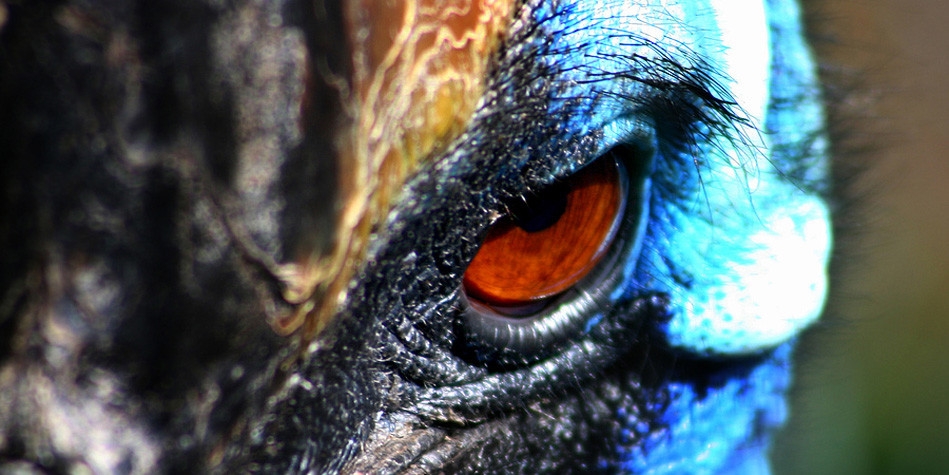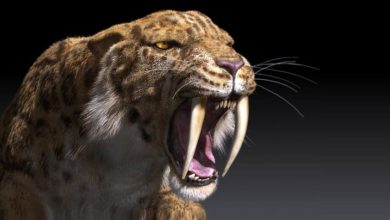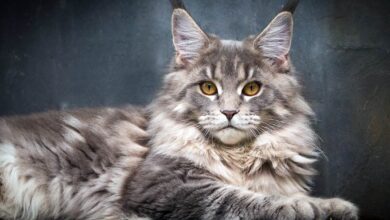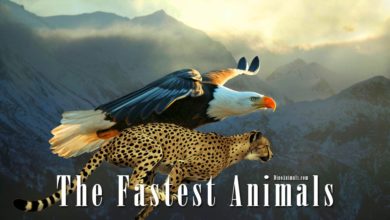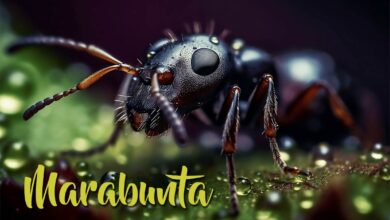The cassowary
The cassowaries
The cassowary – for some people it is beautiful and for others, it is ugly. Its unfriendly facial expression causes that the cassowary are not too popular, although they are very interesting birds. Its neon sky-blue head and the characteristic crest make this bird a weirdo among birds. It is fast as lightning and it can run among dense scrub and trees but it can also kill the human being while defending its territory. What are really cassowaries like?
Classification
- Kingdom: Animalia
- Class: Aves
- Clade: Novaeratitae
- Order: Casuariiformes
- Family: Casuariidae
- Genus: Casuarius
There are three living species of the cassowary and one extinct:
- the southern cassowary (Casuarius casuarius)
- the dwarf cassowary (Casuarius bennetti)
- the northern cassowary (Casuarius unappendiculatus)
- †Casuarius lydekki
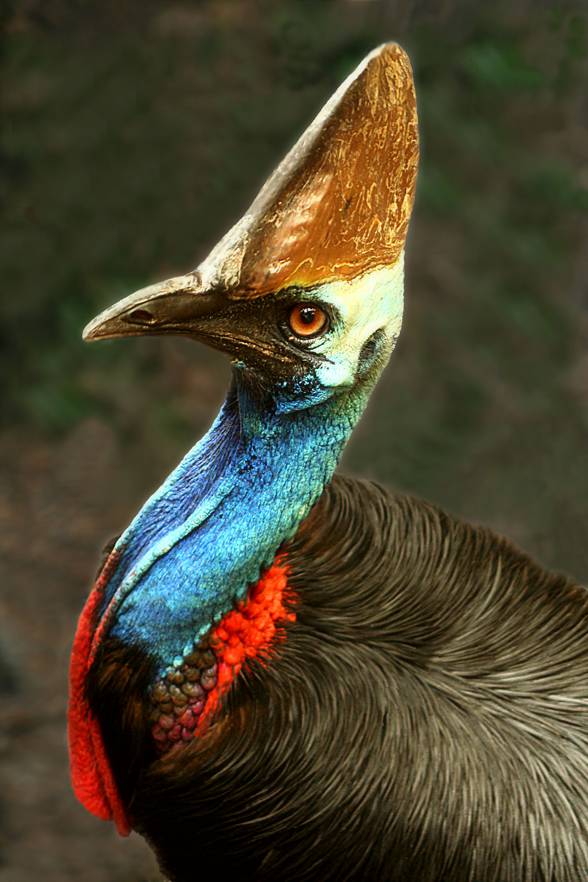
Distribution
All three species of this flightless bird live in New Guinea, nearby islands and in northeastern Australia (Queen Island). The most numerous species is the double-wattled cassowary (Casuarius casuarius), which is the second heaviest bird after the red-necked ostrich (Struthio camelus) and at the same time, the third biggest bird after the common emu (Dromaiidae).
It stays in tropical equatorial forests as well as palm forests, on savannahs, meadows, in swampy woods. It is not known whether some island populations have been there forever or maybe it is the result of merchandising these birds by locals.
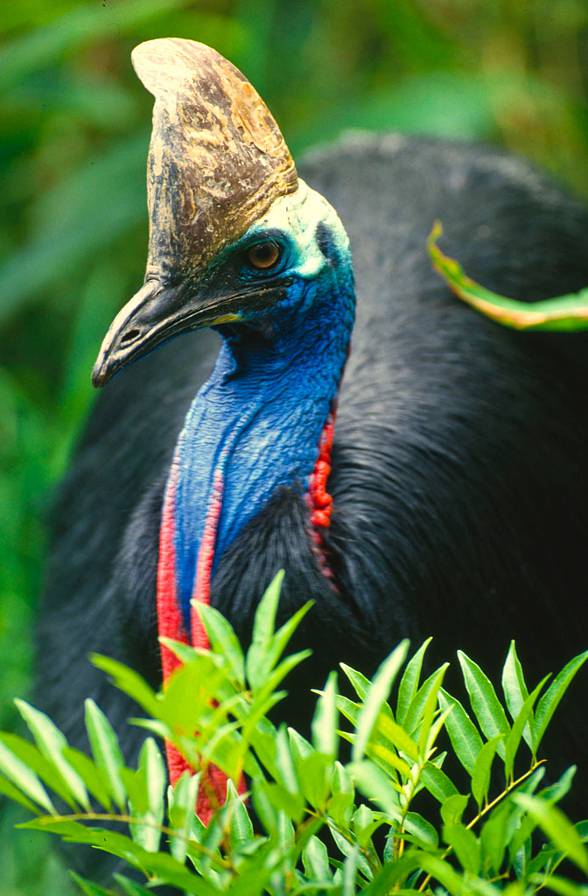
Characteristics
The single-wattled cassowary and the little cassowary are not as well-known as the double-wattled cassowary (although this species is a mystery to a large extent as well) because they are very fast- they escape before the human can notice them nearby. Cassowaries are very shy and spooky birds.
Females are bigger and more colorful than males. The cassowary does not have the preen grand or rectrices (tail feathers). Feathers all over their bodies have hairy shape and they are equipped with barbules. There are 5-6 remeges on small wings. There is the long claw on the second toe of a three-toed foot and it can be up to 125 mm long. It is the fearsome weapon of the cassowary because it defends itself with kicks.
All three species have a spongy ‘horn’ placed on the top of the head called the casque. It is made of the horny flesh. It is supposed that the casque is one of secondary sexual features, the attribute to batter through dense underbrush, the weapon during the dominance fight or the tool to push aside leaf litter while foraging. However, some people think that the casque is used as a resonator, which amplifies deep sounds. What is more, the casque can protect the cassowary against the collision with the tree. It also serves as a helmet in case the fruit falls from the tree. This explanation makes sense because the cassowary spends a lot of time under trees looking for fruit and seeds falling from the height of about 30m and they can be as large as the golf ball.

The southern cassowary, double-wattled cassowary, Australian cassowary, two-wattled cassowary (Casuarius casuarius)
This species of the cassowary lives in tropical equatorial forests of Indonesia, New Guinea, and northeastern Australia at the height of below 1100 m (Australia) and 500 m (New Guinea).
It has black stiff and rough plumage, blue mouth and neck, which is red on the nape. At the front of the neck, there are two red wattles hanging which are 17.8 cm long. On its head, there is the brown casque whose height is from 13 to 16.9 cm. Three-toed feet are thick and enormous and they have pointed claws, which are up to 12 cm long on the second toe.
Both genders have the same plumage but the female, which dominates, has the bigger casque and the beak (additionally, the beak is brighter than the male beak). The young have oblong brown stripes on feathers.
The double-wattled cassowary is the biggest species of the cassowaries and what is more, it is endangered.
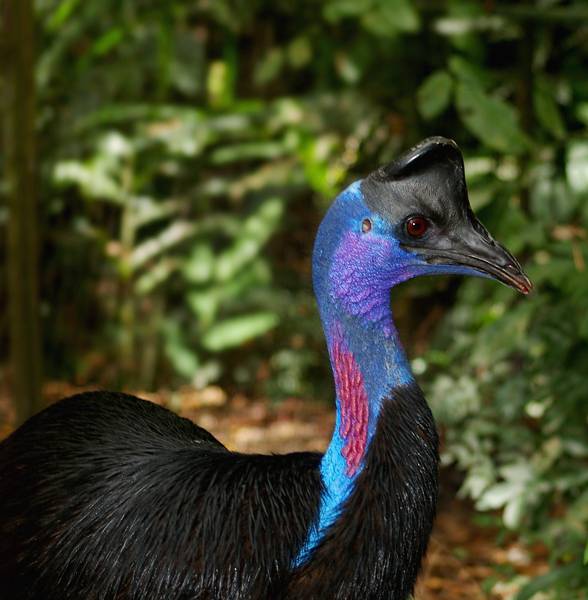
The dwarf cassowary, the Bennett’s cassowary, little cassowary, mountain cassowary, mooruk (Casuarius bennetti)
It lives in alpine forests in New Britain, New Guinea and Yapen at the height of up to 3300 m. Casuarius bennetti can also stay in lowland areas where there are no other species of cassowaries. It is a solitary animal as all cassowaries. It only finds couples during the breeding season.
It has black stiff feathers, small casque on the head in the shape of a pyramid, red marks on the blue neck. In comparison with other cassowaries, this species is shorter and has the smaller beak. Its feet are big and they have pointy claws on middle toes. The female can boast about the longer casque, fairer skin and the bigger size than the male.
There are two subspecies of the Bennett’s cassowary:
- Casuarius bennetti bennetti
- Casuarius bennetti westermanni
The little cassowary is endangered.
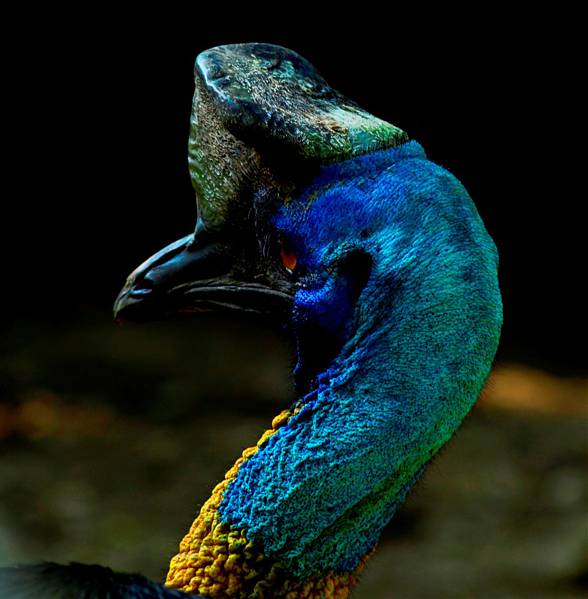
The northern cassowary, the single (one)-wattled cassowary, gold(en)-neck(ed) cassowary (Casuarius unappendiculatus)
It lives in coastal swamps and lowland tropical forests in the north of New Guinea and the island of Yapen as well as Batanta (Indonesia) and Salawati Island (Indonesia). It often stays at the height of not more than 490 m.
Similarly to all cassowaries, this one has black stiff feathers, blue skin on its mouth and the casque on the top of its head. Its neck and wattle can be yellow or red. Strong feet are equipped with long claws. The female is bigger. It is one of the heaviest birds in the world. In comparison with the double-wattled cassowary, the single-wattled cassowary has shorter beak and longer walk (from 28 to 33 cm).
This species is endangered.
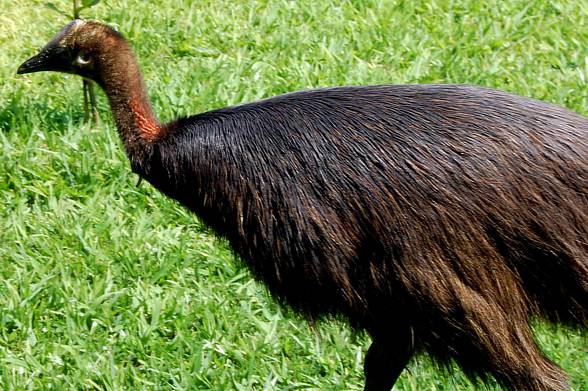
Lifestyle, mating and reproduction
The cassowary leads the solitary lifestyle apart from the mating and breeding period and during the time when there is a lot of food. The male protects its territory, which can reach up to 7 square km. The female territory can overlap a few males’ ranges. Females go cyclically around males’ territories whereas males stay on one area for almost all their lives.
The mating starts with vibratory calling females. The male hearing this approaches the female with its neck being parallel to the ground; then, it does dramatic moves with its head highlighting the front part of the neck. The male knees down on the ground, the female approaches it from its back and stands on its back preparing this way for the copulation or the attack.
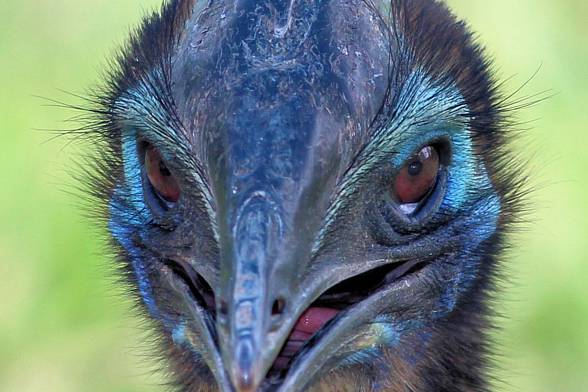
It often happens that the female chases the male in the ritual pursuit until they both are in water. The male dips its neck into the water, the female leads it to the shallows where it does ritual mating moves of its head. The couple can copulate with each other for a very long period of time. It sometimes happens that another male drives the copulating male species away from the female. The newcomer starts copulating with the female. However, it does not work the other way round – females cannot stand the mutual presence during mating.
The breeding period starts in May or June. The female lays from 3 to 5 greenish or green blue big eggs. The female does not take care of eggs. It lays eggs in a few males’ nests. The male incubates them for 50 – 52 days. At this time, it prepares the nest for the young hatching out putting the bedding inside. The father protects its brown-striped children bitterly until they leave the nest, that is for about 9 months. After this period, the young look for the other place to stay.

Diet and the role in the ecosystem
The cassowary eats mainly fruit. Apart from it, it also consumes mushrooms, flowers, snails, frogs, birds, insects, carcass, mice, rats and fish. It likes fruits of the bay, the palm, wild grapes, blueberries as well as the Podocarpaceae. The cassowary can stand under the tree from which there are fruits falling down for a few days until all of them fall down. The cassowary protects its tree against other species. Whole fruits are swallowed even bananas and apples.
The cassowary enriches tropical soils in a very good way because it eats fruit, which fell down on the ground, and then, it excretes the leftovers containing seeds and it sows the jungle with new plants this way. The indicator of the rare tree (Ryporsa) sprouting seeds showed that the effectiveness of sowing these plants is higher after they go through the cassowary’s intestines (even 92% of effectiveness).
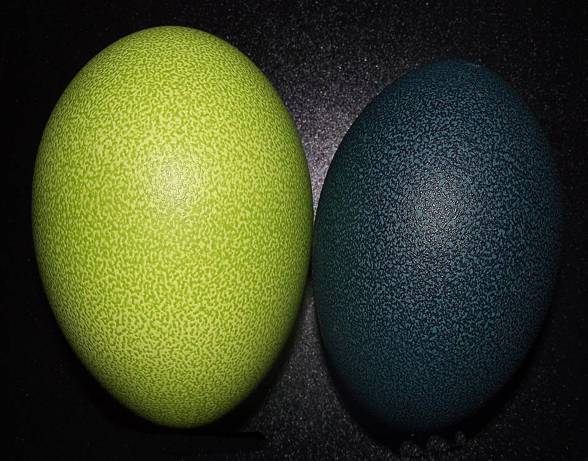
Detailed information/ size
The southern cassowary, double-wattled cassowary, Australian cassowary, two-wattled cassowary (Casuarius casuarius)
- Height: 150-180 cm
- Weight: 17-70 kg
- The length of the jump: up to 1,5 m
- Lifetime: 40-50 years
Dwarf cassowary, Bennett’s cassowary, little cassowary, mountain cassowary, mooruk (Casuarius bennetti)
- Height: 99-150 cm
- Weight: 17,6-26 kg
- The length of the walk: 24,5 cm
- The length of the beak: 11-12,2 cm
Northern cassowary, the one-wattled cassowary, single-wattled cassowary, golden-necked cassowary (Causarius unappendiculatus)
- Height: 150-180 cm
- Weight: 30-58kg
- The length of the walk: 28-33 cm
- The length of the beak: 12-13,7 cm
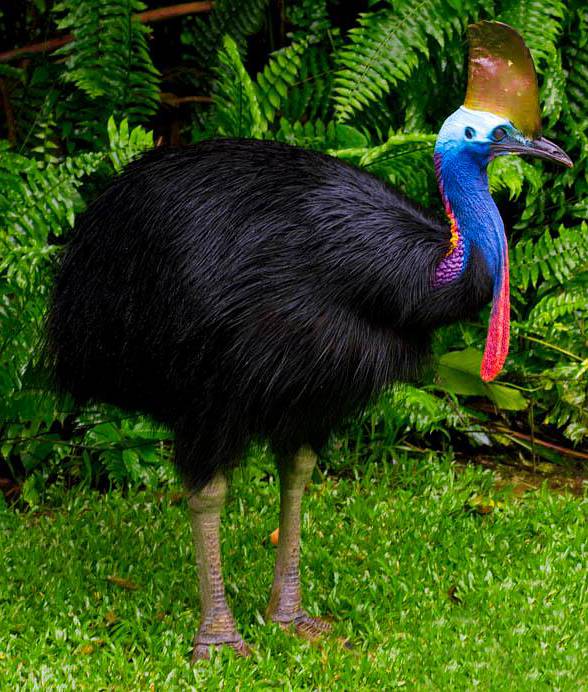
The cassowary – curiosities
- The cassowary can run with the speed of 50 km/h.
- The cassowary is a great swimmer, it can swim the river.
- The double-wattled cassowary and the little cassowary emit sounds of very low frequencies which help them communicate in the dense jungle. This ‘buzzing’ is the deepest tone given out by birds; its frequency is close to the one of inaudible sounds for the human ear.
- During the breeding period, the male is very aggressive. It can attack the opponent and even the human to protect the young.
- The eggs of these flightless birds are from 9 to 14cm long – only the common ostrich and the emu lay bigger eggs although it cannot be noticed on the photo above.
- The cassowary eats fruit of at least 26 species of plants.
- The cassowary sows the consumed seeds with its feces for the distance of over 1km from the place of consuming these seeds.
- The double-wattled cassowary staying in the area of Queensland is endangered.
- In Australia, there are often car collisions with these big flightless birds – it is also the main cause of the drastic decrease of the population of cassowaries.


